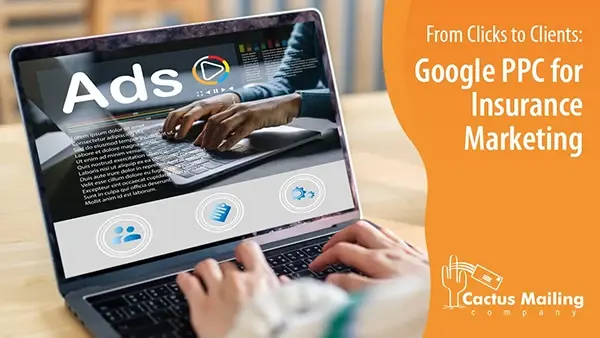We Are Here to Help!
Get pricing details and strategies that will work for your business.
For an insurance agent, Google's Pay-Per-Click (PPC) advertising can be a game-changer for increasing visibility, broadening their reach, and generating valuable leads. While crafting an effective dynamic strategy to suit business needs is key to success on the platform, several challenges need addressing, such as competition among insurers seeking out particular keywords or achieving the right target audience due to ad fatigue while keeping costs under control.
Despite these obstacles, with skilled guidance and optimization techniques, it is possible to ensure a Google ads campaign achieves the desired results without bankrupting your advertising budget. With careful consideration of risks and rewards, a Google Ad allows you as an insurance agency to leverage its full potential, offering great returns from any investment made using this highly powerful toolset.
Navigating this digital terrain requires finesse and understanding, especially when utilizing tools like Google's PPC advertising. In an industry where trust and reliability are paramount, reaching the right audience through the most effective channels is not just beneficial; it's essential.
Understanding Google PPC in the Context of Insurance Marketing
At its core, Google PPC is a model of Internet marketing in which advertisers pay a fee each time one of their ads is clicked. Essentially, it's a way of buying visits to your insurance website rather than attempting to "earn" those visits organically. Google Ads, the most popular PPC advertising system, enables businesses to create ads that appear on Google search engines and other Google properties.
PPC advertising is particularly effective for insurance companies due to its precise targeting capabilities. Whether targeting consumers searching for car insurance quotes or businesses looking for liability coverage, PPC campaigns can be tailored to reach specific audiences.
Why Google PPC is Crucial for Insurance Agents
The insurance sector is highly competitive, and standing out in search results can be challenging. Google PPC allows insurance companies to position their services where potential clients are looking. This positioning is crucial because it increases the likelihood of capturing the attention of someone actively seeking insurance solutions.
Moreover, Google PPC offers the flexibility to adjust campaigns based on performance data, market trends, and customer behavior. This adaptability is vital in the insurance industry, where customer needs and market dynamics can shift rapidly.

Differences Between Organic Search Results and Pay-Per-Click Advertising
The main difference between organic search results through local SEO and PPC advertising is their positioning and appearance. Organic search results are listings on search engine results pages that appear because of their relevance to the search terms. In contrast, PPC are paid advertising placements that appear above or beside organic results.
Users often see organic traffic as more credible, but building it takes time. On the other hand, a PPC ad offers immediate visibility and can provide a quicker return on investment. For an insurance company, combining organic and PPC strategies can be a comprehensive approach to online marketing.
Setting Up Your Google PPC Campaign: A Step-by-Step Guide
When setting up a PPC campaign, create relevant and compelling ad copies that attract your target audience. Use keyword research to identify the most effective keywords for your campaign and optimize your bidding strategy to maximize your ad's visibility. Additionally, consider creating specific landing pages that align with your ad copy to provide a seamless user experience.
Before diving into PPC advertising, you must create a Google Ads account. This process is straightforward and involves providing some basic business information. Once your account is set up, you can start creating your first campaign.
Defining Campaign Goals Specific to Insurance Services
When setting up a Google Ads campaign, it is important to have clear business objectives for your PPC campaign. Are you looking to build brand recognition, create leads, or generate sales for a particular insurance product? Defining these goals upfront will guide your campaign structure and bidding strategy.
To get the best results from your ad spend, you should also set measurable goals like enhancing lead quality, lessening lost deals, and escalating conversion rates, all of which can assist in making sure each dollar spent on an ads campaign helps drive success for your company.
Selecting the Right Keywords for Insurance Products and Targeting the Right Audience
Keyword selection is critical in PPC campaigns. For insurance companies, this means identifying the terms and phrases a potential customer uses to search for insurance services and creating an ad group specific to them. Tools like Google's Keyword Planner can help you find relevant keywords and estimate search volumes.
In addition to selecting the right keywords, targeting the right audience is equally important. Google Ads offers various targeting options, including geographic, demographic, and interest-based targeting, allowing you to tailor your campaign to the most relevant audience.
Budgeting for PPC: How to Allocate Funds Effectively
Effective budgeting is vital to any campaign's success, ensuring your Google Ads reach their intended target market and optimize ROI. Start with a budget you're comfortable with to give you better insight into how exactly Google Ads works and allow more leeway while not having such hefty advertising costs.
Note that CPC (cost-per-click) charges will vary based on the demand/availability of specified keywords. Achieving equilibrium among these keywords is paramount while keeping tabs on expenditures for optimal results. Separate your budget for an insurance product, whether health insurance, life insurance, or car insurance. Remember, the goal is to maximize ROI, not just clicks.

PPC Marketing: Turning Clicks into Clients
Attracting clicks through Google PPC campaigns is just the beginning. The real success lies in what happens after these clicks: conversion optimization. This crucial phase involves transforming potential leads into actual clients. This process requires meticulous strategy and a deep understanding of user behavior. Turning clicks into clients in the insurance sector combines well-crafted ads, optimized landing pages, and intelligent targeting strategies. By focusing on these areas, insurance marketers can increase the effectiveness of their PPC campaigns and ensure a higher return on their advertising investment.
Google Ads Management for Maximum Impact
The effectiveness of your Google PPC campaign in the insurance sector hinges significantly on the quality of your ads. Compelling ad copy is more than words—your first interaction with a potential customer. Here's how to make it count:
- Highlighting Your Unique Value Proposition: Your ad should clearly state what separates your insurance services. Is it your personalized service, comprehensive coverage options, or competitive pricing? Make sure this unique selling point is front and center.
- Clear and Persuasive Language: Use language that speaks directly to your target audience's needs and concerns. Avoid jargon and complex terms. Instead, opt for clear, easy-to-understand language that conveys the benefits of your insurance products.
- Compelling Call-to-Action (CTA): Your CTA is crucial in driving action. Whether it's "Get a Free Quote," "Contact Us Today," or "Learn More About Our Coverage," ensure your CTA is clear, actionable, and creates a sense of urgency.
- Attention-Grabbing Headlines and Descriptions: Your headline should be captivating and relevant to your target keywords. The description should further elaborate on the headline, offering more details and reinforcing the message.
- Using Ad Extensions Effectively: Ad extensions like site links, callouts, and structured snippets enhance your ad by providing additional information and links. These extensions increase your ad's visibility and offer more pathways for potential clients to interact with your business.
Landing Page Optimization for Higher Conversion Rates
A well-designed page boosts conversion and amplifies the general success of your ad campaign. Ensuring that ad copy and content on the landing pages are coherent will offer users a smooth experience with optimum results. With this in mind, linking up elements for successful ad strategies when using Google platforms is crucial.
The journey from a click to a client often pivots on the experience provided by your landing page:
- Relevance and Seamlessness: The content of your landing page should be directly aligned with the promise made in your ad. If your ad offers a free insurance quote, the landing page should facilitate that process straightforwardly.
- Speed and Mobile-Friendliness: With the increasing use of mobile devices, ensure your landing page is optimized for mobile use. It should also load quickly to reduce bounce rates.
- Clarity in Messaging: The message on your landing page should be clear and concise. A well-structured landing page with a straightforward layout, persuasive copy, and an evident call to action can significantly improve conversion rates.
- Utilizing Analytics and A/B Testing: Use Google Analytics to track the performance of your landing page. Conduct A/B testing on various elements like headlines, content, and CTAs to see what resonates best with your audience and leads to higher conversion rates.
Advanced Targeting Techniques for Insurance Ads
Tailoring your ads to the right audience is key in the insurance sector:
- Geographic Targeting: For local insurance providers, targeting ads based on geographic location can drive higher relevance and engagement. Tailoring your message to local needs and specifics can significantly increase conversion rates.
- Demographic Targeting: Utilize demographic information like age, gender, and occupation to target specific segments of the market. For instance, young families might have different insurance needs compared to retirees.
- Remarketing Strategies: Remarketing allows you to target users who have previously interacted with your website but have yet to convert. By displaying relevant ads based on their past interactions, you can remind them of their interest in your services and encourage them to take the final step.

Managing and Optimizing Your PPC Strategy
Optimizing websites for mobile users and maintaining consistent messaging on social media can significantly boost the brand reach and conversion rates of your PPC advertising. Cohesive messaging across social media marketing platforms can reinforce brand identity and lead to higher conversion rates. Regularly managing and adjusting your PPC campaigns is crucial for their long-term success. Effective Google ads management and optimization can significantly enhance their performance and ROI. This continuous process involves several key activities:
- Regular Monitoring and Adjustment: Keep a close eye on your campaign metrics, including click-through rates, conversion rates, and cost per conversion. Use this data to make informed decisions about adjustments to your campaigns, such as tweaking your ad copy, adjusting your bids, or refining your targeting.
- Analyzing Data to Understand User Behavior and Preferences: Dive deep into the analytics to understand how users interact with your ads and landing pages. Look for trends and patterns that can help you tailor your approach more effectively to your target audience's needs and preferences.
- Scaling Successful Campaigns and Pausing Underperforming Ones: Not all campaigns will perform equally. Identify the ones bringing in the most conversions and allocate more resources to them. Conversely, for campaigns that are underperforming, consider pausing them or revising your strategy.
Navigating Challenges and Pitfalls in Insurance PPC
PPC advertising stands as a potent tool for digital marketing. However, like any powerful tool, it has its challenges and pitfalls. Understanding and navigating these challenges is key to the success of any insurance PPC campaign.
1. Recognizing and Avoiding Common Mistakes
One of the most significant challenges in insurance PPC is avoiding common pitfalls that can drain budgets and diminish ROI. These include:
- Neglecting Keyword Research: Not all keywords are created equal in insurance PPC. Failing to conduct thorough keyword research can result in campaigns that target overly broad or irrelevant terms, leading to wasted ad spend and low conversion rates.
- Ignoring Negative Keywords: Equally important is the use of negative keywords. These are terms you don’t want your ad to show up for. For instance, if you’re selling life insurance, you might want to add “car,” “home,” or “health” as negative keywords to ensure your ads don’t appear in these unrelated searches.
- Overlooking Landing Page Optimization: A well-crafted ad is only part of the equation. A common mistake is directing traffic from a well-targeted ad to a poorly optimized landing page, resulting in high bounce rates and low conversions.
2. Navigating the Competitive Landscape
The insurance market is notorious for its fierce competition, particularly in digital advertising. To navigate this:
- Stay Informed About Competitors: Regularly review your competitors’ PPC strategies. Tools like SEMrush or Ahrefs can provide insights into their keyword targeting, ad copy, and landing pages.
- Refine Your USPs: Continuously refine your unique selling propositions. What makes your insurance services stand out? Is it customer service, pricing, or specific coverage options? Your PPC ads should clearly communicate these USPs.
3. Compliance and Legal Considerations
The insurance industry is heavily regulated, and this extends to advertising:
- Adhere to Advertising Regulations: Ensure your PPC ads comply with all relevant regulations and industry standards. This includes being transparent about terms and conditions and avoiding misleading claims.
- Stay Updated on Legal Changes: The legal landscape can change, and it’s crucial to stay updated on any new regulations or compliance requirements that might affect your PPC campaigns.
4. Budget Management and ROI Optimization
Effective budget management is vital for a successful PPC campaign:
- Regular Review and Adjustment of Budgets: Monitor your campaigns closely and adjust your budgets based on their performance. This ensures that your spending is aligned with the campaigns that generate the best ROI.
- Measure and Analyze Campaign Performance: Utilize analytics tools to track key metrics such as click-through rates, conversion rates, and cost per acquisition. This data will help you refine your strategies and optimize your campaigns for better returns.

Conclusion
Google PPC is an incredibly powerful tool for an insurance broker or insurance company looking to convert online clicks into loyal clients. By understanding the basics of PPC, setting up and managing campaigns effectively, and optimizing for conversion, insurance marketers can significantly enhance their online visibility and customer acquisition efforts.
Embrace PPC as a strategic component of your digital marketing mix, but approach it with the understanding that success requires continuous learning, testing, and adaptation. With the right strategy and execution, Google PPC can be a catalyst for growth in the competitive insurance sector.
Our direct mail postcards have helped various businesses get leads, boost brand awareness, and grow revenue. Let us help you create a postcard design to achieve your marketing goals!

 Cactus Mail Team: Jun 28, 2024
Cactus Mail Team: Jun 28, 2024

 Joe McAtee
Joe McAtee

 Nick Ryan
Nick Ryan